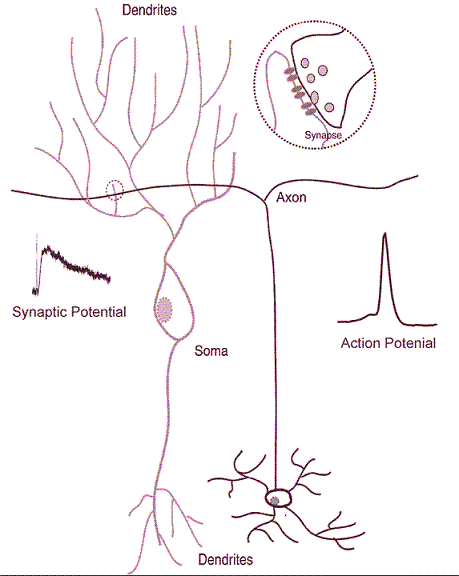Brain Dynamics:
Biology of Spiking Brain Circuits
Neurons are cells in the brain. It is widely believed that neurons are the principal brain cells
that self-organize to bring about cognitive function. Specific groups of neurons are responsible
for memory and learning, perception, and the regulation of bodily function. This section will
give the briefest of introductions to neurons and how they communicate with one another.
Most neurons have three main parts: an axon, a cell body called the soma, and dendrites.
Axons are thin cables that stretch from the soma sometimes for long distances in the brain.
An axon can come quite close to another neuron, usually near the dendrites of that neuron.
Dendrites are also thin cable-like branches that protrude from the soma, often in wild and
complex patterns. The axon will connect, or in neural terms, it will synapse onto the dendrite.
For this reason the cell that the axon comes from is called the pre-synaptic cell while the
cell that the axon synapses onto is called the post-synaptic cell. These are the basics of the
circuitry in the brain.
The next thing to discuss is how this circuitry is used for a communication system.
The cellular membrane of a neuron has the property of excitability: if it gets enough inputs
of a specific type then it will give a stereotyped response. The excitable nature of neurons is
due in part to the fact that they are electrochemical cells; their stereotyped response is a
brief (1-2 ms) voltage spike in their membrane potential (called an action potential). The site of
action potential initiation is often the soma or at least near it.
Once initiated, an action potential
propagates along the axon. When it reaches a synapse it will commence a process that
perturbes the cellular membrane of the post-synaptic cell. This perturbation is called a synaptic
potential. The dendrites transfer the synaptic potential to the soma of the post-synaptic cell. There it will influence the generation of an action potential. Synapses have a polarity,
i.e. they can inhibit or excite the post-synaptic membrane to action potential production. This
process of action potential initiation -> propagation -> synaptic potential -> action potential
initiation/inhibition is the core of the communication system in the brain. A schematic of the
circuitry and action/synaptic potentials are given in Fig. 1.

Figure 1: Neurons and neural communication. A pre-synaptic neuron (right) synapses onto a post synaptic neuron (left). Their
dendrites, somas, and an axon are are labelled. The synaptic connection is expanded in the insert. Examples of the time series for
an action potential and a synaptic potential are also shown. Anne-Marie Oswald generously created the figure.



